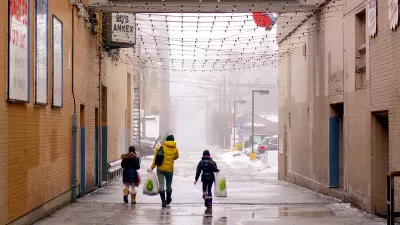Richard Reeves explains the factors that limit or assist social mobility for people born into the lowest economic quintile in American society.
Richard V. Reeves of the Brookings Institution sums up some of his recent findings in a short Youtube video titled "Is America Dreaming?: Understanding Social Mobility," published yesterday. Using Lego blocks and figures, he demonstrates some of the qualities and factors that inhibit or help social mobility, and discusses how these relate to inequality and opportunity.
Reeves explains how American society is top-heavy in terms of economic wealth, the bottom quintile receive five percent of the money while the top quintile receives 52 percent. To understand American economic fairness, which Reeve defines as an individual's ability to advance from the bottom quintile, Reeves analyzes mobility for specific groups in the lower quintile's population: black Americans, white Americans, unmarried parents, married parents, high school dropouts, and college graduates.
Hat tip to Robert Puentes for sharing the video.
FULL STORY: Is America Dreaming?: Understanding Social Mobility

Study: Maui’s Plan to Convert Vacation Rentals to Long-Term Housing Could Cause Nearly $1 Billion Economic Loss
The plan would reduce visitor accommodation by 25,% resulting in 1,900 jobs lost.

North Texas Transit Leaders Tout Benefits of TOD for Growing Region
At a summit focused on transit-oriented development, policymakers discussed how North Texas’ expanded light rail system can serve as a tool for economic growth.

Why Should We Subsidize Public Transportation?
Many public transit agencies face financial stress due to rising costs, declining fare revenue, and declining subsidies. Transit advocates must provide a strong business case for increasing public transit funding.

How to Make US Trains Faster
Changes to boarding platforms and a switch to electric trains could improve U.S. passenger rail service without the added cost of high-speed rail.

Columbia’s Revitalized ‘Loop’ Is a Hub for Local Entrepreneurs
A focus on small businesses is helping a commercial corridor in Columbia, Missouri thrive.

Invasive Insect Threatens Minnesota’s Ash Forests
The Emerald Ash Borer is a rapidly spreading invasive pest threatening Minnesota’s ash trees, and homeowners are encouraged to plant diverse replacement species, avoid moving ash firewood, and monitor for signs of infestation.
Urban Design for Planners 1: Software Tools
This six-course series explores essential urban design concepts using open source software and equips planners with the tools they need to participate fully in the urban design process.
Planning for Universal Design
Learn the tools for implementing Universal Design in planning regulations.
City of Santa Clarita
Ascent Environmental
Institute for Housing and Urban Development Studies (IHS)
City of Grandview
Harvard GSD Executive Education
Toledo-Lucas County Plan Commissions
Salt Lake City
NYU Wagner Graduate School of Public Service





























